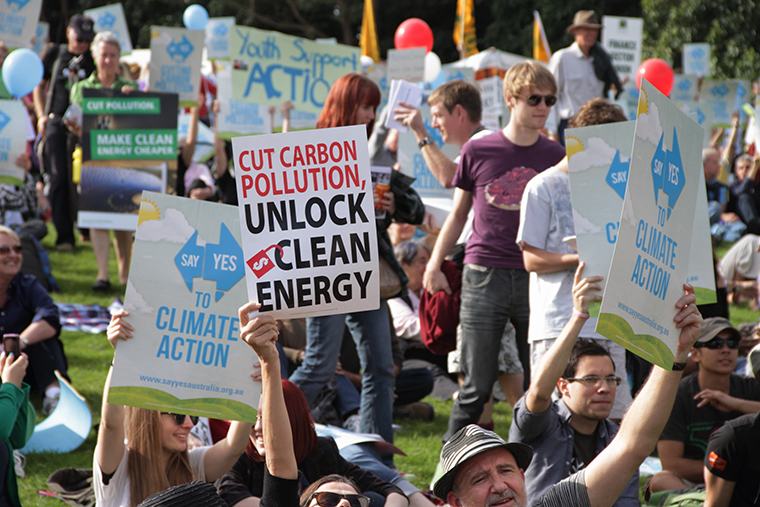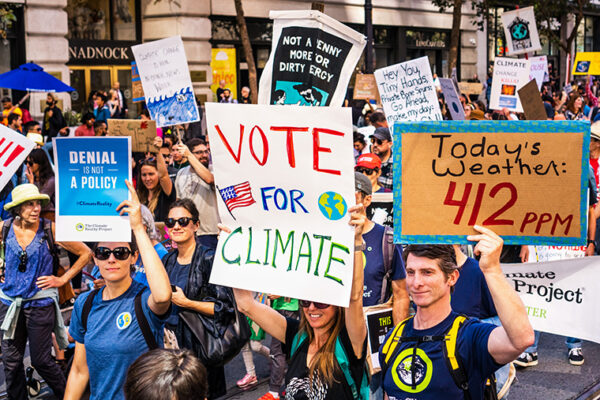For decades, scientists have urged policymakers to take prompt action to address climate change, but their calls have largely gone unanswered. Now, as wildfires ravage the west and hurricanes batter the Atlantic and Gulf coasts with greater intensity, a new study involving Washington University in St. Louis researchers finds consumers across the United States and in some European countries are ready to start paying for it now.

One reason why governments have been slow to react is because of the cost-participation dilemma. In order to be effective, a climate policy must raise the price of carbon and include most countries in the world, explained Michael Bechtel, associate professor of political science in Arts & Sciences. But that’s a challenge because participation is voluntary, and raising energy costs — no matter how necessary — is never popular.
As policymakers debate the best way to fund climate action, Bechtel — along with Kenneth Scheve at Yale University and Elisabeth van Lieshout at Stanford University — wanted to better understand the public’s perspective.
In a study published Sept. 21 in Nature Climate Change, they asked more than 10,000 people in the United States, United Kingdom, Germany and France to consider four different methods of funding climate policies:
- Should the prices start low and gradually increase over time?
- Should prices start high and decrease over time as progress is made?
- Should prices start low, increase over time and then come back down?
- Or, would consumers prefer a constant-cost plan?
Policymakers and pundits have generally assumed that ramping up climate action and costs over time would be the most attractive approach as it would allow consumers to prepare and adjust their energy usage. Instead, they found the majority in all four countries preferred a simpler, constant-cost plan — even if average household costs are high.
Policymakers take note: The constant-cost plan also significantly reduced opposition to climate action, as compared with the ramp-up plan.
According to Bechtel, understanding the public’s preference for funding climate action is important because these costs would likely be passed on to the consumer.
“Even with this type of activity, consumers will ultimately incur higher prices because the increased production costs will require raising the price of such emission-intense goods.”
Michael Bechtel
“Carbon taxes are meant to change energy-intense production as well as consumption patterns, and they would be paid by businesses and consumers,” Bechtel said. “An example is a fuel tax that would directly increase the price of gasoline. A second type of a carbon tax is an emissions tax, which would raise the price of industrial activities that emit greenhouse gases. But even with this type of activity, consumers will ultimately incur higher prices because the increased production costs will require raising the price of such emission-intense goods.”
Researchers began by introducing the notion of an international agreement, which would entail certain average costs per month and household. Respondents were given the four different options of distributing the costs of implementing the agreement over time and asked to indicate which cost schedule they would select in a referendum given a certain cost level average — low or high.
Across the four countries, 58% of respondents preferred the constant-cost plan, whereas only 12% preferred an increasing-cost plan.
Those who favored the constant-cost plan stressed the desire to simplify budgeting and plan for the future. It also encouraged people to reduce their energy usage over time. Even when average household costs were substantial — adding up to 2% of GDP — most respondents still preferred the certainty of the constant plan.
In comparison, those who preferred the ramp-up approach said this plan allowed people to gradually adjust to rising costs. Respondents also chose this option in the hope that delayed costs would leave less of a consumer impact because of wage increases, inflation, etc.
Essential to tackling climate change
Respondents who preferred higher costs up front emphasized the need to make investments now, which they said were essential to tackling climate change.
“Credible climate policies will have to raise the price of carbon, and the public are concerned about these costs even when they believe the science of climate change and generally want governments to address the issue,” the researchers wrote.
“As policymakers seek to design policies that are transparent and meet meaningful emission reduction goals, our research indicates that constant-cost plans promise more support for climate action relative to ramping-up approaches.
“Moreover, due to the delay in large-scale policy responses to climate change, countries will likely have to pursue more progressive and costly climate action to limit the adverse effects of global warming. The drop in support due to higher costs associated with these more ambitious policy efforts may be at least partially mitigated by selecting a set of attractive design features such as the constant distribution of costs.”
Progress appears challenging, but it is possible. The 2016 Paris Agreement created a global framework to address climate change with countries committing to work together to limit the global average temperature increase to 2°C or less. But it stopped short of prescribing which policy instruments countries could use to reach the collective goal.
“Countries have agreed that domestic mitigation measures that reduce greenhouse gas emissions are needed,” Bechtel said. “This is the goal of carbon pricing: Incentivizing societies to produce less GHG emissions. There are several policy instruments that promise to get us closer to this goal. A carbon tax is one of these instruments, but countries can also use emission trading systems or emission reduction funds, for example. They could also rely on a combination of these policies.”



